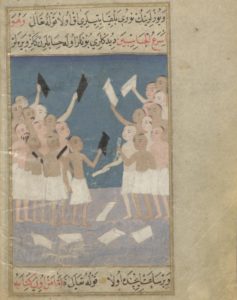
Es regnet Schriften vom Himmel (“It’s Raining Writings from Heaven”) in: Aḥwāl-i qiyāmat aka: Falnama (“Book of Omens”), 16XX © Digitalisierte Sammlungen der Staatsbibliothek zu Berlin Preußischer Kulturbesitz
How does one visualise the invisible, express the inexpressible, or give tactile form to the intangible? According to “Shahāb ad-Dīn” as-Suhrawardī, it is light which “illuminates the powers of imagination and memory…. Love of the light also incites desire, so has the potential to ignite animal rage in the human soul.” In the 12th century, As-Suhrawardī founded the Ishrāqi movement, which derived its name from the verb sharaqa – to rise, shine, radiate. (Sharq in Arabic means “East”.) A blend of metaphysics and mysticism was seen to inspire and illuminate the creative spirit of the human imagination. Sunrise was the metaphor that backlit Ishrāqi philosophy with a nimbus of revelation, an emanation from nur al-anwar—the Light of Lights (i.e., God): inspiring ideas envisioned in a newborn light.
Among Islamicate intellectuals, Greek physiognomy—physical features as emblems of character—became a prophetic ability to see the soul’s destiny. Images of supernatural beings turned into symbols of scientific formulae for the hyper-natural forces of chemo-physics, and alchemical attempts to isolate the Philosophers’ Stone equalled a search for the God-Particle. In genres of fantasy literature, human characters interact with jānn (plural of jinn = genies), Perso-Sanskrit diva, and Greek daimones as temporal narratives for contemplating the atemporal, immortal soul.
Such Islamicate art, literature, and philosophy developed in parallel with concepts of ‘the sublime’ from Longinus to Haeckel’s flüssige Kristallseelen. Modern urges to give voice to personal memory have been expressed in Philip K. Dick’s Do Androids Dream of Electric Sheep?, and Nabokov’s autobiographical Speak, Memory!. The immortalising prose-poem sculptures of Jenny Holzer give contemporary form to the oracle-like enigma of artistic utterance.
Begrüßung
Prof. Dr. Peter-Klaus Schuster
Vorstand Stiftung Brandenburger Tor
Prof. Dr. Claudia Blümle
Humboldt-Universität zu Berlin, Institut für Kunst- und Bildgeschichte
Lecture (in englischer Sprache)
Prof. Dr. David Brafman
Empfang
bis 22 Uhr
Prof. Dr. David Brafman
David Brafman is curator of rare books at the Getty Research Institute in Los Angeles. Recent exhibitions he has curated include: SCRATCH (2014) – a collaborative installation between early modern rare books and 150 of LA’s leading graffiti and tattoo artists); The Cave Temples of Dunhuang: Buddhist Art on China’s Silk Road (Getty Center: 2016); The Art of Alchemy (Getty Research Institute, 2016/17); which was expanded in collaboration with Jörg Völlnagel and Veronika Tocher (Generaldirektion – Staatliche Museen zu Berlin) as Alchemie: die große Kunst (Kulturforum, 2017). Prof. Brafman’s PhD is in Classics and Arabic from Duke University. He was born and grew up in Brooklyn, New York.
He has been teaching two Arnheim Seminars: One The Art of Memory, and the other: Genies, Demons, and Dīvas: Illuminated Visions in Islam and the Sublime View from the West.
Die Rudolf-Arnheim-Gastprofessur
Die Rudolf-Arnheim-Gastprofessur geht auf den Filmkritiker und Filmhistoriker Rudolf Arnheim zurück, der die Theorie des „denkenden Sehens“ und Gestaltens entwickelte. Eine hochrangige interdisziplinäre Jury beruft jährlich einen ausländischen Gastdozenten an die Humboldt-Universität. Gefördert wird diese Professur durch den Deutschen Akademischen Austauschdienst, die Stiftung Preußischer Kulturbesitz und die Stiftung Brandenburger Tor.








